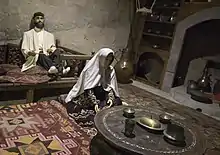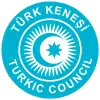Seljuk Empire
The Great Seljuk Empire[11][lower-alpha 1] (Persian: آل سلجوق, romanized: Āl-e Saljuq, lit. 'House of Saljuq') or the Seljuk Empire was a high medieval Turko-Persian[14] Sunni Muslim empire, originating from the Qiniq branch of Oghuz Turks.[15] At its greatest extent, the Seljuk Empire controlled a vast area stretching from western Anatolia and the Levant to the Hindu Kush in the east, and from Central Asia to the Persian Gulf in the south.
Great Seljuk Empire آلِ سلجوق Āl-e Saljuq | |
|---|---|
| 1037–1194 | |
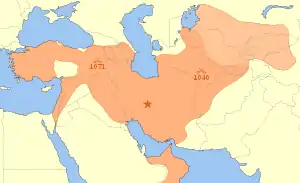 Seljuk Empire at its greatest extent in 1092, upon the death of Malik Shah I. | |
| Status | Empire |
| Capital | |
| Common languages | |
| Religion | Sunni Islam (Hanafi) |
| Government | De facto: Independent Sultanate De jure: Under Caliphate[6] |
| Caliph | |
• 1031–1075 | Al-Qa'im |
• 1180–1225 | Al-Nasir |
| Sultan | |
• 1037–1063 | Toghrul I (first) |
• 1174–1194 | Toghrul III (last)[7] |
| History | |
• Tughril formed the state system | 1037 |
| 1040 | |
| 1071 | |
| 1095–1099 | |
| 1141 | |
| 1194 | |
| Area | |
| 1080 est.[9][10] | 3,900,000 km2 (1,500,000 sq mi) |
| History of the Turkic peoples pre–14th century |
|---|
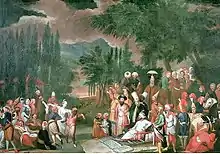 History of the Turkic peoples |
| Tiele people |
| Göktürks |
|
| Khazar Khaganate 618–1048 |
| Xueyantuo 628–646 |
| Kangar union 659–750 |
| Turk Shahi 665-850 |
| Türgesh Khaganate 699–766 |
| Kimek confederation 743–1035 |
| Uyghur Khaganate 744–840 |
| Oghuz Yabgu State 750–1055 |
| Karluk Yabgu State 756–940 |
| Kara-Khanid Khanate 840–1212 |
| Ganzhou Uyghur Kingdom 848–1036 |
| Qocho 856–1335 |
| Pecheneg Khanates 860–1091 |
| Ghaznavid Empire 963–1186 |
| Seljuk Empire 1037–1194 |
| Cuman–Kipchak confederation 1067–1239 |
| Khwarazmian Empire 1077–1231 |
| Kerait Khanate 11th century–13th century |
| Delhi Sultanate 1206–1526 |
| Qarlughid Kingdom 1224–1266 |
| Golden Horde 1240s–1502 |
| Mamluk Sultanate (Cairo) 1250–1517 |
The Seljuk empire was founded by Tughril Beg (990–1063) and his brother Chaghri Beg (989–1060) in 1037. From their homelands near the Aral Sea, the Seljuks advanced first into Khorasan and then into mainland Persia, before eventually capturing Baghdad and conquering eastern Anatolia. Here the Seljuks won the battle of Manzikert in 1071 and conquered most of Anatolia from the Byzantine Empire, which became one of the reasons for the First Crusade (1095–1099). Starting from 1140s, the Seljuk empire declined, and was eventually replaced by the Khwarazmian Empire in 1194.
Seljuk gave his name to both the empire and the Seljuk dynasty. The Seljuks united the fractured political landscape of the eastern Islamic world and played a key role in the first and second crusades. Highly Persianized[16] in culture[17] and language,[18] the Seljuks also played an important role in the development of the Turko-Persian tradition,[19] even exporting Persian culture to Anatolia.[20][21] The settlement of Turkic tribes in the northwestern peripheral parts of the empire, for the strategic military purpose of fending off invasions from neighboring states, led to the progressive Turkicization of those areas.[22]
Founder of the dynasty
The apical ancestor of the Seljuks was their bey Seljuk. He was reputed to have served in the Khazar army, under whom, the Seljuks migrated to Khwarezm, near the city of Jend, where they converted to Islam in 985.[23] Khwarezm, administered by the Ma'munids, was under the nominal control of the Samanid Empire.[24] By 999 the Samanids fell to the Kara-Khanids in Transoxania, however, the Ghaznavids occupied the lands south of the Oxus.[25] The Seljuks became involved, having supported the last Samanid emir against the Kara-Khanids, in this power struggle in the region before establishing their own independent base.[26]
Expansion of the empire
Tughril and Chaghri
The grandson of Seljuk, Tughril, under whom the Seljuks wrested an empire from the Ghaznavids. Initially the Seljuks were repulsed by Mahmud and retired to Khwarezm, but Tughril and Chaghri led them to capture Merv and Nishapur (1037/38).[27] Later they repeatedly raided and traded territory with his successor, Mas'ud, across Khorasan and Balkh.[28]
In 1040, at the Battle of Dandanaqan, they decisively defeated Mas'ud I of the Ghaznavids, forcing him to abandon most of his western territories to the Seljuks.[29] By 1046, the Caliph al-Qa'im had sent Tughril a diploma recognizing Seljuk rule over Khurasan.[30] In 1048–9, the Seljuk Turks commanded by Ibrahim Yinal, uterine brother of the sultan Tughril, made their first incursion in Byzantine frontier region of Iberia and clashed with a combined Byzantine-Georgian army of 50,000 at the Battle of Kapetrou on 10 September 1048. The devastation left behind by the Seljuk raid was so fearful that the Byzantine magnate Eustathios Boilas described, in 1051/52, those lands as "foul and unmanageable... inhabited by snakes, scorpions, and wild beasts." The Arab chronicler Ibn al-Athir reports that Ibrahim brought back 100,000 captives and a vast booty loaded on the backs of ten thousand camels.[31] In 1055, Tughril entered Baghdad and removed the Shia Buyid influence, under a commission from the Abbasid Caliph.[30]
Alp Arslan
Alp Arslan, the son of Chaghri Beg, expanded significantly upon Tughril's holdings by adding Armenia and Georgia in 1064 and invading the Byzantine Empire in 1068, from which he annexed almost all of Anatolia.[32] Arslan's decisive victory at the Battle of Manzikert in 1071 effectively neutralized the Byzantine resistance to the Turkish invasion of Anatolia.[33] Although the Georgians were able to recover from Alp Arslan's invasion by securing the theme of Iberia. The Byzantine withdrawal from Anatolia brought Georgia in more direct contact with the Seljuks. In 1073 the Seljuk Amirs of Ganja, Dvin and Dmanisi, invaded Georgia and were defeated by George II of Georgia, who successfully took the fortress of Kars.[34] A retaliatory strike by the Seljuk Amir Ahmad defeated the Georgians at Kvelistsikhe.[35]
Alp Arslan authorized his Turkmen generals to carve their own principalities out of formerly Byzantine Anatolia, as atabegs loyal to him. Within two years the Turkmens had established control as far as the Aegean Sea under numerous beghliks (modern Turkish beyliks): the Saltukids in Northeastern Anatolia, the Shah-Armens and the Mengujekids in Eastern Anatolia, Artuqids in Southeastern Anatolia, Danishmendis in Central Anatolia, Rum Seljuks (Beghlik of Suleyman, which later moved to Central Anatolia) in Western Anatolia, and the Beylik of Tzachas of Smyrna in İzmir (Smyrna).
Malik Shah I
Under Alp Arslan's successor, Malik Shah, and his two Persian viziers, Nizām al-Mulk and Tāj al-Mulk, the Seljuk state expanded in various directions, to the former Iranian border of the days before the Arab invasion, so that it soon bordered China in the east and the Byzantines in the west. Malikshāh was the one who moved the capital from Rey to Isfahan.[36] It was under his rule and leadership that the Saljūq Empire had reached the height of its successes.[37] The Iqta military system and the Nizāmīyyah University at Baghdad were established by Nizām al-Mulk, and the reign of Malikshāh was reckoned the golden age of "Great Seljuk". The Abbasid Caliph titled him "The Sultan of the East and West" in 1087. The Assassins (Hashshashin) of Hassan-i Sabāh started to become a force during his era, however, and they assassinated many leading figures in his administration; according to many sources these victims included Nizām al-Mulk.
In 1076 Malik Shah I surged into Georgia and reduced many settlements to ruins. from 1079/80 onward, Georgia was pressured into submitting to Malik-Shah to ensure a precious degree of peace at the price of an annual tribute.
Ahmad Sanjar
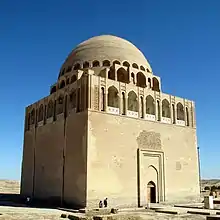
Ahmad was the son of Malik Shah I and initially took part in wars of succession against his three brothers and a nephew: Mahmud I, Barkiyaruq, Malik Shah II and Muhammad I Tapar. In 1096, he was tasked to govern the province of Khorasan by his brother Muhammad I.[38] Over the next several years, Ahmad Sanjar became the ruler of most of Iran (Persia), and eventually in 1118, the sole ruler of the Great Seljuk Empire.[39]
In 1141, Ahmad marched to eliminate the threat posed by Kara Khitans and faced them in the vicinity of Samarkand at the Battle of Qatwan. He suffered his first defeat in his long career, and as a result lost all Seljuk territory east of the Syr Darya.[40][41]
Sanjar's as well as Seljuks' rule collapsed as a consequence of yet another unexpected defeat, this time at the hands of the Seljuks’ own tribe, in 1153.[39] Sanjar was captured during the battle and held in captivity until 1156.[42] It brought chaos to the Empire - situation later exploited by the victorious Turkmens, whose hordes would overrun Khorasan unopposed, wreaking colossal damage on the province and prestige of Sanjar.[42] Sanjar eventually escaped from captivity in the fall of 1156, but soon died in Merv (present-day Turkmenistan), in 1157. After his death, Turkic rulers, Turkmen tribal forces, and other secondary powers competed for Khorasan, and after a long period of confrontations, the province was finally conquered by Khwarazmians in the early 1200s.[43]
Tomb of Ahmed Sanjar was destroyed by the Mongols led by Tolui, who sacked the city of Merv in 1221, killing 700,000 people according to contemporary sources during their catastrophic invasion of Khwarazm;[44] however, modern scholarship holds such figures to be exaggerated.[45][46]
Governance
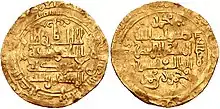
The Seljuk power was indeed at its zenith under Malikshāh I, and both the Qarakhanids and Ghaznavids had to acknowledge the overlordship of the Seljuks.[47] The Seljuk dominion was established over the ancient Sasanian domains, in Iran and Iraq, and included Anatolia, Syria, as well as parts of Central Asia and modern Afghanistan.[47] The Seljuk rule was modelled after the tribal organization common in Turkic and Mongol nomads and resembled a 'family federation' or 'appanage state'.[47] Under this organization, the leading member of the paramount family assigned family members portions of his domains as autonomous appanages.[47]
Various emblems and banners have been recorded to be used by the Seljuks in different periods. Early Seljuks were using their traditional emblems, but the gradually adopted local Muslim signs and banners. The official flag of the empire was most probably a black flag, similar to the flag of the Abbasid Caliphate. The flag was decorated with signs, which were either superimposed over it, or was placed above the flag.[48]
Division of empire
When Malikshāh I died in 1092, the empire split as his brother and four sons quarrelled over the apportioning of the empire among themselves. Malikshāh I was succeeded in Anatolia by Kilij Arslan I, who founded the Sultanate of Rum, and in Syria by his brother Tutush I. In Persia he was succeeded by his son Mahmud I, whose reign was contested by his other three brothers Barkiyaruq in Iraq, Muhammad I in Baghdad, and Ahmad Sanjar in Khorasan. When Tutush I died, his sons Radwan and Duqaq inherited Aleppo and Damascus respectively and contested with each other as well, further dividing Syria amongst emirs antagonistic towards each other.
In 1118, the third son Ahmad Sanjar took over the empire. His nephew, the son of Muhammad I, did not recognize his claim to the throne, and Mahmud II proclaimed himself Sultan and established a capital in Baghdad, until 1131 when he was finally officially deposed by Ahmad Sanjar.
Elsewhere in nominal Seljuk territory were the Artuqids in northeastern Syria and northern Mesopotamia; they controlled Jerusalem until 1098. The Dānišmand dynasty founded a state in eastern Anatolia and northern Syria and contested land with the Sultanate of Rum, and Kerbogha exercised independence as the atabeg of Mosul.
First Crusade (1095–1099)
%252C_the_son_of_Malikshah_(r._1072%E2%80%931092)%252C_from_a_Manuscript_of_Hafiz-i_Abru%E2%80%99s_Majma%E2%80%99_al-tawarikh_-_1952.51.9_-_Yale_University_Art_Gallery.jpg.webp)
During the First Crusade, the fractured states of the Seljuks were generally more concerned with consolidating their own territories and gaining control of their neighbours than with cooperating against the crusaders. The Seljuks easily defeated the People's Crusade arriving in 1096, but they could not stop the progress of the army of the subsequent Princes' Crusade, which took important cities such as Nicaea (İznik), Iconium (Konya), Caesarea Mazaca (Kayseri), and Antioch (Antakya) on its march to Jerusalem (Al-Quds). In 1099 the crusaders finally captured the Holy Land and set up the first Crusader states. The Seljuks had already lost Palestine to the Fatimids, who had recaptured it just before its capture by the crusaders.
After pillaging the County of Edessa, Seljukid commander Ilghazi made peace with the Crusaders. In 1121 he went north towards Georgia and with supposedly up to 250 000 – 350 000 troops, including men led by his son-in-law Sadaqah and Sultan Malik of Ganja, he invaded the Kingdom of Georgia.[49][50] David IV of Georgia gathered 40,000 Georgian warriors, including 5,000 monaspa guards, 15,000 Kipchaks, 300 Alans and 100 French Crusaders to fight against Ilghazi's vast army. The Battle of Didgori was fought between the armies of the Kingdom of Georgia and the Seljuk Empire, on August 12, 1121. As a result, the Seljuks were routed and fled from the battlefield, being run down by pursuing Georgian cavalry for several days. The Didgori battle helped the Crusader states, which had been under the pressure of Ilghazi's armies. The weakening of the main enemy of the Latin principalities was beneficial for the Kingdom of Jerusalem under King Baldwin II.
Second Crusade (1147–1149)
During this time conflict with the Crusader states was also intermittent, and after the First Crusade increasingly independent atabegs would frequently ally with the Crusader states against other atabegs as they vied with each other for territory. At Mosul, Zengi succeeded Kerbogha as atabeg and successfully began the process of consolidating the atabegs of Syria. In 1144 Zengi captured Edessa, as the County of Edessa had allied itself with the Artuqids against him. This event triggered the launch of the Second Crusade. Nur ad-Din, one of Zengi's sons who succeeded him as atabeg of Aleppo, created an alliance in the region to oppose the Second Crusade, which landed in 1147.
Decline
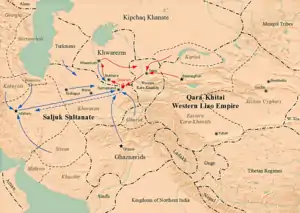
Ahmad Sanjar fought to contain the revolts by the Kara-Khanids in Transoxiana, Ghurids in Afghanistan and Qarluks in modern Kyrghyzstan, as well as the nomadic invasion of the Kara-Khitais in the east. The advancing Kara-Khitais first defeated the Eastern Kara-Khanids, then followed up by crushing the Western Kara-Khanids, who were vassals of the Seljuks at Khujand. The Kara-Khanids turned to their overlord the Seljuks for assistance, to which Sanjar responded by personally leading an army against the Kara-Khitai. However, Sanjar's army was decisively defeated by the host of Yelu Dashi at the Battle of Qatwan on September 9, 1141. While Sanjar managed to escape with his life, many of his close kin including his wife were taken captive in the battle's aftermath. As a result of Sanjar's failure to deal with the encroaching threat from the east, the Seljuk Empire lost all its eastern provinces up to the river Syr Darya, and vassalage of the Western Kara-Khanids was usurped by the Kara-Khitai, otherwise known as the Western Liao in Chinese historiography.[51]
Conquest by Khwarezm and the Ayyubids
In 1153, the Ghuzz (Oghuz Turks) rebelled and captured Sanjar. He managed to escape after three years but died a year later. The atabegs, such as Zengids and Artuqids, were only nominally under the Seljuk Sultan, and generally controlled Syria independently. When Ahmad Sanjar died in 1157, this fractured the empire even further and rendered the atabegs effectively independent.
- Khorasani Seljuks in Khorasan and Transoxiana. Capital: Merv
- Kermani Seljuks
- Sultanate of Rum (or Seljuks of Turkey). Capital: Iznik (Nicaea), later Konya (Iconium)
- Atabeghlik of the Salghurids in Fars
- Atabeghlik of Eldiguzids (Atabeg of Azerbaijan[52]) in Iraq and Azerbaijan.[53] Capital: Nakhchivan[54] (1136–1175), Hamadan (1176–1186), Tabriz[55] (1187–1225)
- Atabeghlik of Bori in Syria. Capital: Damascus
- Atabeghlik of Zangi in Al Jazira (Northern Mesopotamia). Capital: Mosul
- Turcoman Beghliks: Danishmendis, Artuqids, Saltuqids and Mengujekids in Asia Minor
After the Second Crusade, Nur ad-Din's general Shirkuh, who had established himself in Egypt on Fatimid land, was succeeded by Saladin. In time, Saladin rebelled against Nur ad-Din, and, upon his death, Saladin married his widow and captured most of Syria and created the Ayyubid dynasty.
On other fronts, the Kingdom of Georgia began to become a regional power and extended its borders at the expense of Great Seljuk. The same was true during the revival of the Armenian Kingdom of Cilicia under Leo II of Armenia in Anatolia. The Abbasid caliph An-Nasir also began to reassert the authority of the caliph and allied himself with the Khwarezmshah Takash.
For a brief period, Togrul III was the Sultan of all Seljuk except for Anatolia. In 1194, however, Togrul was defeated by Takash, the Shah of Khwarezmid Empire, and the Seljuk Empire finally collapsed. Of the former Seljuk Empire, only the Sultanate of Rûm in Anatolia remained.
As the dynasty declined in the middle of the thirteenth century, the Mongols invaded Anatolia in the 1260s and divided it into small emirates called the Anatolian beyliks. Eventually one of these, the Ottoman, would rise to power and conquer the rest.
Legacy
The Seljuks were educated in the service of Muslim courts as slaves or mercenaries. The dynasty brought revival, energy, and reunion to the Islamic civilization hitherto dominated by Arabs and Persians.
The Seljuks founded universities and were also patrons of art and literature. Their reign is characterized by Persian astronomers such as Omar Khayyám, and the Persian philosopher al-Ghazali. Under the Seljuks, New Persian became the language for historical recording, while the center of Arabic language culture shifted from Baghdad to Cairo.[56]
List of sultans of the Seljuk Empire
| # | Laqab | Throne name | Reign | Marriages | Succession right |
|---|---|---|---|---|---|
| 1 | Rukn ad-Dunya wa ad-Din رکن الدنیا والدین, |
Toghrul-Beg | 1037–1063 | 1) Altun Jan Khatun (2) Aka Khatun (3) Fulana Khatun (daughter of Abu Kalijar) (4) Seyyidah Khatun (daughter of Al-Qa'im, Abbasid caliph) (5) Fulana Khatun (widow of Chaghri Beg) |
son of Mikail (grandson of Seljuk) |
| 2 | Diya ad-Dunya wa ad-Din Adud ad-Dawlah ضياء الدنيا و الدين عضد الدولة |
Alp Arslan | 1063–1072 | 1) Aka Khatun (widow of Toghrul I) (2) Safariyya Khatun (daughter of Yusuf Qadir Khan, Khagan of Kara-Khanid) (3) Fulana Khatun (daughter of Smbat Lorhi) (4) Fulana Khatun (daughter of Kurtchu bin Yunus bin Seljuk) |
son of Chaghri |
| 3 | Muizz ad-Dunya wa ad-Din Jalal ad-Dawlah معز الدین جلال الدولہ |
Malik-Shah I | 1072–1092 | 1) Turkan Khatun (daughter of Ibrahim Tamghach Khan, Khagan of Western Kara-Khanid) (2) Zubeida Khatun (daughter of Yaquti ibn Chaghri) (3) Safariyya Khatun (daughter of Isa Khan, Sultan of Samarkand) (4) Fulana Khatun (daughter of Romanos IV Diogenes) |
son of Alp Arslan |
| 4 | Nasir ad-Dunya wa ad-Din ناصر الدنیا والدین |
Mahmud I | 1092–1094 | son of Malik-Shah I | |
| 5 | Rukn ad-Dunya wa ad-Din رکن الدنیا والدین |
Barkiyaruq | 1094–1105 | son of Malik-Shah I | |
| 6 | Rukn ad-Dunya wa ad-Din Jalal ad-Dawlah رکن الدنیا والدین جلال الدولہ |
Malik-Shah II | 1105 | son of Barkiyaruq | |
| 7 | Ghiyath ad-Dunya wa ad-Din غیاث الدنیا والدین |
Tapar | 1105–1118 | 1) Nisandar Jihan Khatun (2) Gouhar Khatun (daughter of Isma'il bin Yaquti) (3) Fulana Khatun (daughter of Aksungur Beg) |
son of Malik-Shah I |
| 8 | Mughith ad-Dunya wa ad-Din Jalal ad-Dawlah مُغيث الدنيا و الدين جلال الدولة |
Mahmud II | 1118–1131 | 1) Mah-i Mulk Khatun (died 1130) (daughter of Sanjar) (2) Amir Siti Khatun (daughter of Sanjar) (3) Ata Khatun (daughter of Ali bin Faramarz) |
son of Muhammad I |
| 9 | Muizz ad-Dunya wa ad-Din Adud ad-Dawlah مُعز الدنيا و الدين جلال الدولة |
Sanjar | 1118–1153 | 1) Turkan Khatun (daughter of Muhammad Arslan Khan, Khagan of Western Kara-Khanid) (2) Rusudan Khatun (daughter of Demetrius I of Georgia) (3) Gouhar Khatun (daughter of Isma'il bin Yaquti, widow of Tapar) (4) Fulana Khatun (daughter of Arslan Khan, a Qara Khitai prisoner) |
son of Malik-Shah I |
| 10 | Ghiyath ad-Dunya wa ad-Din غیاث الدنیا والدین |
Dawud | 1131–1132 | Gouhar Khatun (daughter of Masud) |
son of Mahmud II |
| 11 | Rukn ad-Dunya wa ad-Din رکن الدنیا والدین |
Toghrul II | 1132–1135 | 1) Mumine Khatun (mother of Arslan-Shah) (2) Zubeida Khatun (daughter of Barkiyaruq) |
son of Muhammad I |
| 12 | Ghiyath ad-Dunya wa ad-Din غیاث الدنیا والدین |
Masud | 1135–1152 | 1) Gouhar Nasab Khatun (daughter of Sanjar) (2) Zubeida Khatun (daughter of Barkiyaruq, widow of Toghrul II) (3) Mustazhiriyya Khatun (daughter of Qawurd) (4) Sufra Khatun (daughter of Dubais) (5) Arab Khatun (daughter of Al-Muqtafi) (6) Ummiha Khatun (daughter of Amid ud-Deula bin Juhair) (7) Abkhaziyya Khatun (daughter of David IV of Georgia) (8) Sultan Khatun (mother of Malik-Shah III) |
son of Muhammad I |
| 13 | Muin ad-Dunya wa ad-Din مُعين الدنيا و الدين |
Malik-Shah III | 1152–1153 | son of Mahmud II | |
| 14 | Rukn ad-Dunya wa ad-Din رکن الدنیا والدین |
Muhammad | 1153–1159 | 1) Mahd Rafi Khatun (daughter of Kirman-Shah) (2) Gouhar Khatun (daughter of Masud, widow of Dawud) (3) Kerman Khatun (daughter of Al-Muqtafi) (4) Kirmaniyya Khatun (daughter of Tughrul Shah, ruler of Kerman) |
son of Mahmud II |
| 15 | Ghiyath ad-Dunya wa ad-Din غیاث الدنیا والدین |
Suleiman-Shah | 1159–1160 | 1) Khwarazmi Khatun (daughter of Muhammad Khwarazm Shah) (2) Abkhaziyya Khatun (daughter of David IV of Georgia, widow of Masud) |
son of Muhammad I |
| 16 | Muizz ad-Dunya wa ad-Din معز الدنیا والدین |
Arslan-Shah | 1160–1176 | 1) Kerman Khatun (daughter of Al-Muqtafi, widow of Muhammad) (2) Sitti Fatima Khatun (daughter of Ala ad-Daulah) (3) Kirmaniyya Khatun (daughter of Tughrul Shah, ruler of Kerman, widow of Muhammad) (4) Fulana Khatun (sister of Izz al-Din Hasan Qipchaq) |
son of Toghrul II |
| 17 | Rukn ad-Dunya wa ad-Din رکن الدنیا والدین |
Toghrul III | 1176–1191 1st reign |
Inanj Khatun (daughter of Sunqur-Inanj, ruler of Rey, widow of Toghrul III) |
son of Arslan-Shah |
| 18 | Muzaffar ad-Dunya wa ad-Din مظفر الدنیا والدین |
Qizil Arslan | 1191 | Inanj Khatun (daughter of Sunqur-Inanj, ruler of Rey, widow of Muhammad ibn Ildeniz) |
son of Ildeniz (stepbrother of Arslan-Shah) |
| — | Rukn ad-Dunya wa ad-Din رکن الدنیا والدین |
Toghrul III | 1192–1194 2nd reign |
son of Arslan-Shah | |
Seljuk art
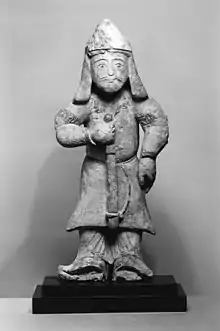 Seljuk stucco figurine (12th century)
Seljuk stucco figurine (12th century) Seljuk pottery head
Seljuk pottery head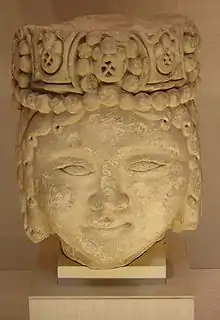 Head of male royal figure, 12–13th century, found in Iran.
Head of male royal figure, 12–13th century, found in Iran. Seljuk female figurine
Seljuk female figurine Seljuk female figurine
Seljuk female figurine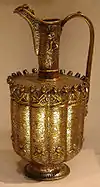 Seljuk-era art: Ewer from Herat, Afghanistan, dated 1180–1210CE. Brass worked in repousse and inlaid with silver and bitumen. British Museum.
Seljuk-era art: Ewer from Herat, Afghanistan, dated 1180–1210CE. Brass worked in repousse and inlaid with silver and bitumen. British Museum.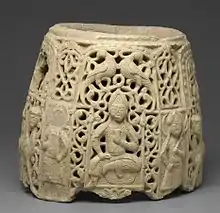 Section of a Water Jug, Habb, 12th-13th century, Brooklyn Museum
Section of a Water Jug, Habb, 12th-13th century, Brooklyn Museum Bowl with an Enthronement Scene,12th-13th century, Brooklyn Museum
Bowl with an Enthronement Scene,12th-13th century, Brooklyn Museum
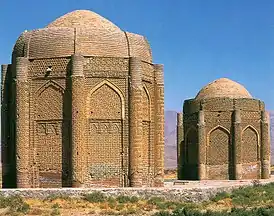 The Kharāghān twin towers, built in 1053 in Iran, is the burial of Seljuk princes.
The Kharāghān twin towers, built in 1053 in Iran, is the burial of Seljuk princes.
See also
Notes
- In order to distinguish from the Anatolian branch of the family, the Sultanate of Rum.[12][13]
References
- Savory, R. M., ed. (1976). Introduction to Islamic Civilisation. Cambridge University Press. p. 82. ISBN 978-0-521-20777-5.
- Black, Edwin (2004). Banking on Baghdad: Inside Iraq's 7,000-year History of War, Profit and Conflict. John Wiley and Sons. p. 38. ISBN 978-0-471-67186-2.
- C.E. Bosworth, "Turkish Expansion towards the west" in UNESCO History of Humanity, Volume IV, titled "From the Seventh to the Sixteenth Century", UNESCO Publishing / Routledge, p. 391: "While the Arabic language retained its primacy in such spheres as law, theology and science, the culture of the Seljuk court and secular literature within the sultanate became largely Persianized; this is seen in the early adoption of Persian epic names by the Seljuk rulers (Qubād, Kay Khusraw and so on) and in the use of Persian as a literary language (Turkish must have been essentially a vehicle for everyday speech at this time)."
- Stokes 2008, p. 615.
- Concise Encyclopedia of Languages of the World, Ed. Keith Brown, Sarah Ogilvie, (Elsevier Ltd., 2009), 1110; "Oghuz Turkic is first represented by Old Anatolian Turkish which was a subordinate written medium until the end of the Seljuk rule."
- Holt, Peter M. (1984). "Some Observations on the 'Abbāsid Caliphate of Cairo". Bulletin of the School of Oriental and African Studies. University of London. 47 (3): 501–507. doi:10.1017/s0041977x00113710.
- Grousset, Rene, The Empire of the Steppes, (New Brunswick: Rutgers University Press, 1988), 167.
- Grousset, Rene (1988). The Empire of the Steppes. New Brunswick: Rutgers University Press. pp. 159, 161. ISBN 978-0-8135-0627-2.
In 1194, Togrul III would succumb to the onslaught of the Khwarizmian Turks, who were destined at last to succeed the Seljuks to the empire of the Middle East.
- Turchin, Peter; Adams, Jonathan M.; Hall, Thomas D. (December 2006). "East-West Orientation of Historical Empires". Journal of World-Systems Research. 12 (2): 223. ISSN 1076-156X. Retrieved 13 September 2016.
- Rein Taagepera (September 1997). "Expansion and Contraction Patterns of Large Polities: Context for Russia". International Studies Quarterly. 41 (3): 496. doi:10.1111/0020-8833.00053. JSTOR 2600793.
-
- A. C. S. Peacock, Great Seljuk Empire, (Edinburgh University Press, 2015), 1–378
- Christian Lange; Songül Mecit, eds., Seljuqs: Politics, Society and Culture (Edinburgh University Press, 2012), 1–328
- P.M. Holt; Ann K.S. Lambton, Bernard Lewis, The Cambridge History of Islam (Volume IA): The Central Islamic Lands from Pre-Islamic Times to the First World War, (Cambridge University Press, 1977), 151, 231–234.
- Mecit 2014, p. 128.
- Peacock & Yıldız 2013, p. 6.
-
- "Aḥmad of Niǧde's al-Walad al-Shafīq and the Seljuk Past", A. C. S. Peacock, Anatolian Studies, Vol. 54, (2004), 97; "With the growth of Seljuk power in Rum, a more highly developed Muslim cultural life, based on the Persianate culture of the Seljuk court, was able to take root in Anatolia."
- Meisami, Julie Scott, Persian Historiography to the End of the Twelfth Century, (Edinburgh University Press, 1999), 143; "Nizam al-Mulk also attempted to organise the Saljuq administration according to the Persianate Ghaznavid model k..."
- Encyclopaedia Iranica, "Šahrbānu", Online Edition: "here one might bear in mind that non-Persian dynasties such as the Ghaznavids, Saljuqs and Ilkhanids were rapidly to adopt the Persian language and have their origins traced back to the ancient kings of Persia rather than to Turkish heroes or Muslim saints ..."
- Josef W. Meri, Medieval Islamic Civilization: An Encyclopedia, Routledge, 2005, p. 399
- Michael Mandelbaum, Central Asia and the World, Council on Foreign Relations (May 1994), p. 79
- Jonathan Dewald, Europe 1450 to 1789: Encyclopedia of the Early Modern World, Charles Scribner's Sons, 2004, p. 24: "Turcoman armies coming from the East had driven the Byzantines out of much of Asia Minor and established the Persianized sultanate of the Seljuks."
- Grousset, Rene, The Empire of the Steppes, (Rutgers University Press, 1991), 161, 164; "renewed the Balls of ur dad
-
- Jackson, P. (2002). "Review: The History of the Seljuq Turkmens: The History of the Seljuq Turkmens". Journal of Islamic Studies. Oxford Centre for Islamic Studies. 13 (1): 75–76. doi:10.1093/jis/13.1.75.
- Bosworth, C. E. (2001). 0Notes on Some Turkish Names in Abu 'l-Fadl Bayhaqi's Tarikh-i Mas'udi". Oriens, Vol. 36, 2001 (2001), pp. 299–313.
- Dani, A. H., Masson, V. M. (Eds), Asimova, M. S. (Eds), Litvinsky, B. A. (Eds), Boaworth, C. E. (Eds). (1999). History of Civilizations of Central Asia. Motilal Banarsidass Publishers (Pvt. Ltd).
- Hancock, I. (2006). On Romani origins and identity. The Romani Archives and Documentation Center. The University of Texas at Austin.
- Asimov, M. S., Bosworth, C. E. (eds.). (1998). History of Civilizations of Central Asia, Vol. IV: "The Age of Achievement: AD 750 to the End of the Fifteenth Century", Part One: "The Historical, Social and Economic Setting". Multiple History Series. Paris: UNESCO Publishing.
- Dani, A. H., Masson, V. M. (Eds), Asimova, M. S. (Eds), Litvinsky, B. A. (Eds), Boaworth, C. E. (Eds). (1999). History of Civilizations of Central Asia. Motilal Banarsidass Publishers (Pvt. Ltd).
-
- Encyclopaedia Iranica, "Šahrbānu", Online Edition: "here one might bear in mind that non-Persian dynasties such as the Ghaznavids, Saljuqs and Ilkhanids were rapidly to adopt the Persian language and have their origins traced back to the ancient kings of Persia rather than to Turkish heroes or Muslim saints ..."
- Josef W. Meri, "Medieval Islamic Civilization: An Encyclopedia", Routledge, 2005, p. 399
- Michael Mandelbaum, "Central Asia and the World", Council on Foreign Relations (May 1994), p. 79
- Jonathan Dewald, "Europe 1450 to 1789: Encyclopedia of the Early Modern World", Charles Scribner's Sons, 2004, p. 24: "Turcoman armies coming from the East had driven the Byzantines out of much of Asia Minor and established the Persianized sultanate of the Seljuks."
-
- C.E. Bosworth, "Turkmen Expansion towards the west" in UNESCO History of Humanity, Volume IV, titled "From the Seventh to the Sixteenth Century", UNESCO Publishing / Routledge, p. 391: "While the Arabic language retained its primacy in such spheres as law, theology and science, the culture of the Seljuk court and secular literature within the sultanate became largely Persianized; this is seen in the early adoption of Persian epic names by the Seljuk rulers (Qubād, Kay Khusraw and so on) and in the use of Persian as a literary language (Turkmen must have been essentially a vehicle for everyday speech at this time). The process of Persianization accelerated in the thirteenth century with the presence in Konya of two of the most distinguished refugees fleeing before the Mongols, Bahā' al-Dīn Walad and his son Mawlānā Jalāl al-Dīn Rūmī, whose Mathnawī, composed in Konya, constitutes one of the crowning glories of classical Persian literature."
- Mehmed Fuad Köprülü, "Early Mystics in Turkish Literature", Translated by Gary Leiser and Robert Dankoff, Routledge, 2006, p. 149: "If we wish to sketch, in broad outline, the civilization created by the Seljuks of Anatolia, we must recognize that the local—i.e., non-Muslim, element was fairly insignificant compared to the Turkish and Arab-Persian elements, and that the Persian element was paramount. The Seljuk rulers, to be sure, who were in contact with not only Muslim Persian civilization, but also with the Arab civilizations in al-jazlra and Syria—indeed, with all Muslim peoples as far as India—also had connections with {various} Byzantine courts. Some of these rulers, like the great 'Ala' al-Dln Kai-Qubad I himself, who married Byzantine princesses and thus strengthened relations with their neighbors to the west, lived for many years in Byzantium and became very familiar with the customs and ceremonial at the Byzantine court. Still, this close contact with the ancient Greco-Roman and Christian traditions only resulted in their adoption of a policy of tolerance toward art, aesthetic life, painting, music, independent thought—in short, toward those things that were frowned upon by the narrow and piously ascetic views {of their subjects}. The contact of the common people with the Greeks and Armenians had basically the same result. [Before coming to Anatolia,] the Turkmens had been in contact with many nations and had long shown their ability to synthesize the artistic elements that they had adopted from these nations. When they settled in Anatolia, they encountered peoples with whom they had not yet been in contact and immediately established relations with them as well. Ala al-Din Kai-Qubad I established ties with the Genoese and, especially, the Venetians at the ports of Sinop and Antalya, which belonged to him, and granted them commercial and legal concessions. Meanwhile, the Mongol invasion, which caused a great number of scholars and artisans to flee from Turkmenistan, Iran, and Khwarazm and settle within the Empire of the Seljuks of Anatolia, resulted in a reinforcing of Persian influence on the Anatolian Turks. Indeed, despite all claims to the contrary, there is no question that Persian influence was paramount among the Seljuks of Anatolia. This is clearly revealed by the fact that the sultans who ascended the throne after Ghiyath al-Din Kai-Khusraw I assumed titles taken from ancient Persian mythology, like Kai-Khusraw, Kai-Ka us, and Kai-Qubad; and that. Ala' al-Din Kai-Qubad I had some passages from the Shahname inscribed on the walls of Konya and Sivas. When we take into consideration domestic life in the Konya courts and the sincerity of the favor and attachment of the rulers to Persian poets and Persian literature, then this fact [i.e., the importance of Persian influence] is undeniable. With regard to the private lives of the rulers, their amusements, and palace ceremonial, the most definite influence was also that of Iran, mixed with the early Turkish traditions, and not that of Byzantium."
- Stephen P. Blake, Shahjahanabad: The Sovereign City in Mughal India, 1639–1739. Cambridge University Press, 1991. pg 123: "For the Seljuks and Il-Khanids in Iran it was the rulers rather than the conquered who were "Persianized and Islamicized"
-
- Encyclopaedia Iranica, "Šahrbānu", Online Edition: "here one might bear in mind that non-Persian dynasties such as the Ghaznavids, Saljuqs and Ilkhanids were rapidly to adopt the Persian language and have their origins traced back to the ancient kings of Persia rather than to Turkish heroes or Muslim saints ..."
- O.Özgündenli, "Persian Manuscripts in Ottoman and Modern Turkish Libraries Archived 2012-01-22 at the Wayback Machine", Encyclopaedia Iranica, Online Edition
- M. Ravandi, "The Seljuq court at Konya and the Persianisation of Anatolian Cities", in Mesogeios (Mediterranean Studies), vol. 25-6 (2005), pp. 157–69
- F. Daftary, "Sectarian and National Movements in Iran, Khorasan, and Trasoxania during Umayyad and Early Abbasid Times", in History of Civilizations of Central Asia, Vol 4, pt. 1; edited by M.S. Asimov and C.E. Bosworth; UNESCO Publishing, Institute of Ismaili Studies: "Not only did the inhabitants of Khurasan not succumb to the language of the nomadic invaders, but they imposed their own tongue on them. The region could even assimilate the Turkic Ghaznavids and Seljuks (eleventh and twelfth centuries), the Timurids (fourteenth–fifteenth centuries), and the Qajars (nineteenth–twentieth centuries) ..."
- "The Turko-Persian tradition features Persian culture patronized by Turkic rulers." See Daniel Pipes: "The Event of Our Era: Former Soviet Muslim Republics Change the Middle East" in Michael Mandelbaum, "Central Asia and the World: Kazakhstan, Uzbekistan, Tajikistan, Kyrgyzstan, Turkemenistan and the World", Council on Foreign Relations, p. 79. Exact statement: "In Short, the Turko-Persian tradition featured Persian culture patronized by Turcophone rulers."
- Grousset, Rene, The Empire of the Steppes, (Rutgers University Press, 1991), 574.
- Bingham, Woodbridge, Hilary Conroy and Frank William Iklé, History of Asia, Vol.1, (Allyn and Bacon, 1964), 98.
-
- An Introduction to the History of the Turkic Peoples (Peter B. Golden. Otto Harrasowitz, 1992). pg 386: "Turkic penetration probably began in the Hunnic era and its aftermath. Steady pressure from Turkic nomads was typical of the Khazar era, although there are no unambiguous references to permanent settlements. These most certainly occurred with the arrival of the Oguz in the 11th century. The Turkicization of much of Azarbayjan, according to Soviet scholars, was completed largely during the Ilxanid period if not by late Seljuk times. Sumer, placing a slightly different emphasis on the data (more correct in my view), posts three periods which Turkicization took place: Seljuk, Mongol and Post-Mongol (Qara Qoyunlu, Aq Qoyunlu and Safavid). In the first two, Oguz Turkic tribes advanced or were driven to the western frontiers (Anatolia) and Northern Azarbaijan (Arran, the Mugan steppe). In the last period, the Turkic elements in Iran (derived from Oguz, with lesser admixture of Uygur, Qipchaq, Qaluq and other Turks brought to Iran during the Chinggisid era, as well as Turkicized Mongols) were joined now by Anatolian Turks migrating back to Iran. This marked the final stage of Turkicization. Although there is some evidence for the presence of Qipchaqs among the Turkic tribes coming to this region, there is little doubt that the critical mass which brought about this linguistic shift was provided by the same Oguz-Turkmen tribes that had come to Anatolia. The Azeris of today are an overwhelmingly sedentary, detribalized people. Anthropologically, they are little distinguished from the Iranian neighbors."
- John Perry: "We should distinguish two complementary ways in which the advent of the Turks affected the language map of Iran. First, since the Turkish-speaking rulers of most Iranian polities from the Ghaznavids and Seljuks onward were already Iranized and patronized Persian literature in their domains, the expansion of Turk-ruled empires served to expand the territorial domain of written Persian into the conquered areas, notably Anatolia and Central and South Asia. Secondly, the influx of massive Turkish-speaking populations (culminating with the rank and file of the Mongol armies) and their settlement in large areas of Iran (particularly in Azerbaijan and the northwest), progressively turkicized local speakers of Persian, Kurdish and other Iranian languages"
- According to C.E. Bosworth:
- According to Fridrik Thordarson:
- Peacock 2015, p. 25.
- Peacock 2015, p. 26.
- Frye 1975, p. 159.
- Peacock 2015, p. 27.
- Peacock 2010, p. 92-93.
- Basan 2010, p. 61-62.
- Basan 2010, p. 62.
- Basan 2010, p. 66.
- Paul A. Blaum (2005). Diplomacy gone to seed: a history of Byzantine foreign relations, A.D. 1047–57. International Journal of Kurdish Studies. (Online version)
- Canby, Sheila R.; Beyazit, Deniz; Rugiadi, Martina; Peacock, A. C. S. (2016-04-27). Court and Cosmos: The Great Age of the Seljuqs. Metropolitan Museum of Art. ISBN 9781588395894.
- Princeton, University. "Dhu'l Qa'da 463/ August 1071 The Battle of Malazkirt (Manzikert)". Retrieved 2007-09-08.
- Battle of Partskhisi, Historical Dictionary of Georgia, ed. Alexander Mikaberidze, (Rowman & Littlefield, 2015), 524.
- Georgian-Saljuk Wars (11th–13th Centuries), Alexander Mikaberidze, Conflict and Conquest in the Islamic World: A Historical Encyclopedia, Vol. I, ed. Alexander Mikaberidze, (ABC-CLIO, 2011), 334.
- Korobeinikov 2015, p. 71.
- Virani, Shafique N. (2018-04-16). "Alamūt, Ismailism and Khwāja Qāsim Tushtarī's Recognizing God". Shii Studies Review. 2 (1–2): 193–227. doi:10.1163/24682470-12340021. ISSN 2468-2462.
- Grousset, René (1970) The Empire of the Steppes Rutgers University Press, New Brunswick, New Jersey, USA, p. 159, ISBN 0-8135-0627-1
- "SANJAR, Aḥmad b. Malekšāh" Encyclopædia Iranica
- Ibn al-Athir as cited by Zarncke, Friedrich (1879) Der Priester Johannes S. Heizel, Leipzig, p. 856-857 OCLC 7619779
- Liao Shih (the official history of the Khitan Dynasty) cited by Wittfogel, Karl A. and Feng Chia-Sheng (1949) History of Chinese Society: Liao, 907–1125 American Philosophical Society, Philadelphia, p. 639 OCLC 9811810
- Sinor, Denis (1990). The Cambridge History of Early Inner Asia. Cambridge: Cambridge University Press. p. 368. ISBN 0-521-24304-1.
- C. Edmond Bosworth, "The Political and Dynastic History of the Iranian World (A.D. 1000–1217)," Camb. Hist. Iran V, 1968, pp.94–185
- Saunders, John Joseph (1971). The History of the Mongol Conquests. University of Pennsylvania Press. p. 60.
- https://thediplomat.com/2015/06/the-desolation-of-merv/
- Tertius Chandler & Gerald Fox, "3000 Years of Urban Growth", pp. 232–236
- Wink, Andre, Al Hind the Making of the Indo Islamic World, Brill Academic Publishers, Jan 1, 1996, ISBN 90-04-09249-8 pg 9–10
- کوپریلی، فؤاد (۱۳۷۹). «پرچم٫ ۱:تاریخچه پرچم در جهان اسلام». در حداد عادل، غلامعلی. دانشنامه جهان اسلام. ۵. تهران: بنیاد دایرةالمعارف اسلامی. بایگانیشده از اصلی در ۱ آوریل ۲۰۲۰.
- Mikaberidze, Alexander. "'Miraculous Victory:' Battle of Didgori, 1121". Armchair General. Retrieved 2012-10-20.
- Anatol Khazanov. Nomads in the Sedentary World. Retrieved 2012-10-20.
- Biran, Michel, The Empire of the Qara Khitai in Eurasian History, (Cambridge University Press, 2005), 44.
- Hodgson, Marshall G.S. The Venture of Islam: Conscience and History in a World Civilization, University of Chicago Press, 1974, ISBN 0-226-47693-6, p. 260
- Bosworth, Clifford Edmund (1996). The New Islamic Dynasties: A Chronological and Genealogical Manual. Columbia University Press. pp. 199–200. ISBN 978-0-231-10714-3.
pp 199-200(Eldiguizds or Ildegizds): "The Elgiguzids or Ildegizds were a Turkish Atabeg dynasty who controlled most of Azerbaijan(apart from the region of Maragha held by another Atabeg line, the Ahamadilis), Arran and northern Jibal during the second half the twelfth century when the Great Seljuq Sultane of Western Persia and Iraq was in full decay and unable to prevent the growth of virtually independent powers in the province", pp 199–200: "Eldiguz (Arabic-Persian sources write 'y.l.d.k.z) was originally a Qipchaq military slave", pp199-200: "The historical significance of these Atabegs thus lies in their firm control over most of north-western Persia during the later Seljuq periodand also their role in Transcaucasia as champions of Islamagainst the resurgent Bagtarid Kings". pp 199: "In their last phase, the Eldiguzids were once more local rulers in Azerbaijan and eastern Transcaucasia, hard pressed by the aggressive Georgians, and they did not survive the troubled decades of the thirteenth century".
- Encyclopaedia Iranica. K. A. Luther "Atabakan-e Adarbayjan": Sources such as Ḥosaynī’s Aḵbār (p. 181 and passim) make it clear that members of the family always considered Naḵǰavān their home base.
- Houtsma, M. T. E.J. Brill's First Encyclopaedia of Islam, 1913–1936, BRILL, 1987, ISBN 90-04-08265-4, p. 1053
- Andre Wink, Al-Hind: The Making of the Indo-Islamic World, Vol.2, 16. – via Questia (subscription required)
- Özaydın, Abdülkerim (2002). KAVURD BEY (PDF). 25. İstanbul: TDV İslâm Ansiklopedisi. pp. 73–74. ISBN 978-9-7538-9403-6.
- Zahîrüddîn-i Nîsâbûrî, Selcûḳnâme, (Muhammed Ramazânî Publications), Tahran 1332, p. 10.
- Reşîdüddin Fazlullāh-ı Hemedânî, Câmiʿu’t-tevârîḫ, (Ahmed Ateş Publications), Ankara 1960, vol. II/5, p. 5.
- Râvendî, Muhammed b. Ali, Râhatü’s-sudûr, (Ateş Publications), vol. I, p. 85.
- Müstevfî, Târîḫ-i Güzîde, (Nevâî Publications), p. 426.
- Osman Gazi Özgüdenli (2016). MÛSÂ YABGU. EK-2. İstanbul: TDV İslâm Ansiklopedisi. pp. 324–325.
- Sevim, Ali (1991). ATSIZ b. UVAK (PDF). 4. İstanbul: TDV İslâm Ansiklopedisi. p. 92-93. ISBN 978-9-7538-9431-9.
- Sümer, Faruk (2002). KUTALMIŞ (PDF). 26. İstanbul: TDV İslâm Ansiklopedisi. pp. 480–481. ISBN 978-9-7538-9406-7.
- Sevim, Ali (1993). ÇAĞRI BEY (PDF). 8. İstanbul: TDV İslâm Ansiklopedisi. pp. 183–186. ISBN 978-9-7538-9435-7.
- Beyhakī, Târîḫ, (Behmenyâr), p. 71.
- Alptekin, Coşkun (1989). AKSUNGUR (PDF). 2. İstanbul: TDV İslâm Ansiklopedisi. p. 196. ISBN 978-9-7538-9429-6.
- Sümer, Faruk (2009). SELÇUKLULAR (PDF). 36. İstanbul: TDV İslâm Ansiklopedisi. pp. 365–371. ISBN 978-9-7538-9566-8.
- Sümer, Faruk (2009). Kirman Selçuks (PDF). 36. İstanbul: TDV İslâm Ansiklopedisi. p. 377-379. ISBN 978-9-7538-9566-8.
- Özaydın, Abdülkerim (2012). TUTUŞ (PDF). 41. İstanbul: TDV İslâm Ansiklopedisi. pp. 446–449. ISBN 978-9-7538-9713-6.
- Sümer, Faruk (2009). SELÇUKS of Syria (PDF). 36. İstanbul: TDV İslâm Ansiklopedisi. pp. 385–386. ISBN 978-9-7538-9566-8.
- Bezer, Gülay Öğün (2011). TERKEN HATUN, the mother of MAHMÛD I (PDF). 40. İstanbul: TDV İslâm Ansiklopedisi. p. 510. ISBN 978-9-7538-9652-8. Terken Khatun (wife of Malik-Shah I).
- Özaydın, Abdülkerim (2004). MELİKŞAH (PDF). 29. İstanbul: TDV İslâm Ansiklopedisi. pp. 54–57. ISBN 978-9-7538-9415-9.
- Sümer, Faruk (1991). ARSLAN ARGUN (PDF). 3. İstanbul: TDV İslâm Ansiklopedisi. p. 399-400. ISBN 978-9-7538-9430-2.
- Özaydın, Abdülkerim (1992). BERKYARUK (PDF). 5. İstanbul: TDV İslâm Ansiklopedisi. p. 514-516. ISBN 978-9-7538-9432-6.
- Özaydın, Abdülkerim (2005). MUHAMMED TAPAR (PDF). 30. İstanbul: TDV İslâm Ansiklopedisi. pp. 579–581. ISBN 978-9-7538-9425-8.
- Özaydın, Abdülkerim (2009). AHMED SENCER (PDF). 36. İstanbul: TDV İslâm Ansiklopedisi. pp. 507–511. ISBN 978-9-7538-9566-8.
- Sümer, Faruk (2009). Irak Selçuks (PDF). 36. İstanbul: TDV İslâm Ansiklopedisi. p. 387. ISBN 978-9-7538-9566-8.
- Özaydın, Abdülkerim (2003). MAHMÛD b. MUHAMMED TAPAR of Irak Selçuks (PDF). 27. İstanbul: TDV İslâm Ansiklopedisi. p. 371-372. ISBN 978-9-7538-9408-1.
- Sümer, Faruk (2012). TUĞRUL I of Irak Selçuks (PDF). 41. İstanbul: TDV İslâm Ansiklopedisi. p. 341-342. ISBN 978-9-7538-9713-6.
- Sümer, Faruk (2004). MES‘ÛD b. MUHAMMED TAPAR of Irak Selçuks (PDF). 29. İstanbul: TDV İslâm Ansiklopedisi. p. 349-351. ISBN 978-9-7538-9415-9.
- Sümer, Faruk (1991). ARSLANŞAH b. TUĞRUL of Irak Selçuks (PDF). 3. İstanbul: TDV İslâm Ansiklopedisi. p. 404-406. ISBN 978-9-7538-9430-2.
- Sümer, Faruk (2012). Ebû Tâlib TUĞRUL b. ARSLANŞAH b. TUĞRUL of Irak Selçuks (PDF). 41. İstanbul: TDV İslâm Ansiklopedisi. p. 342-344. ISBN 978-9-7538-9713-6.
Sources
- Basan, Osman Aziz (2010). The Great Seljuqs: A History. Taylor & Francis.
- Frye, R.N. (1975). "The Samanids". In Frye, R.N. (ed.). The Cambridge History of Iran. 4:The Period from the Arab invasion to the Saljuqs. Cambridge University Press.
- Korobeinikov, Dimitri (2015). "The Kings of the East and the West: The Seljuk Dynastic Concept and Titles in the Muslim and Christian sources". In Peacock, A.C.S.; Yildiz, Sara Nur (eds.). The Seljuks of Anatolia. I.B. Tauris.
- Peacock, Andrew C. S. (2010). Early Seljūq History: A New Interpretation.
- Peacock, A.C.S.; Yıldız, Sara Nur, eds. (2013). The Seljuks of Anatolia: Court and Society in the Medieval Middle East. I.B.Tauris. ISBN 978-1848858879.
- Peacock, A.C.S. (2015). The Great Seljuk Empire. Edinburgh University Press.
- Mecit, Songül (2014). The Rum Seljuqs: Evolution of a Dynasty. Routledge. ISBN 978-1134508990.
Further reading
- Previté-Orton, C. W. (1971). The Shorter Cambridge Medieval History. Cambridge: Cambridge University Press.
- Tetley, G. E. (2008). The Ghaznavid and Seljuk Turks: Poetry as a Source for Iranian History. Abingdon. ISBN 978-0-415-43119-4.
- Stokes, Jamie, ed. (2008). Encyclopedia of the Peoples of Africa and the Middle East. New York: Facts On File. ISBN 978-0-8160-7158-6. Archived from the original on 2017-02-14.
External links
| Wikisource has the text of The New Student's Reference Work article "Seljuks". |
